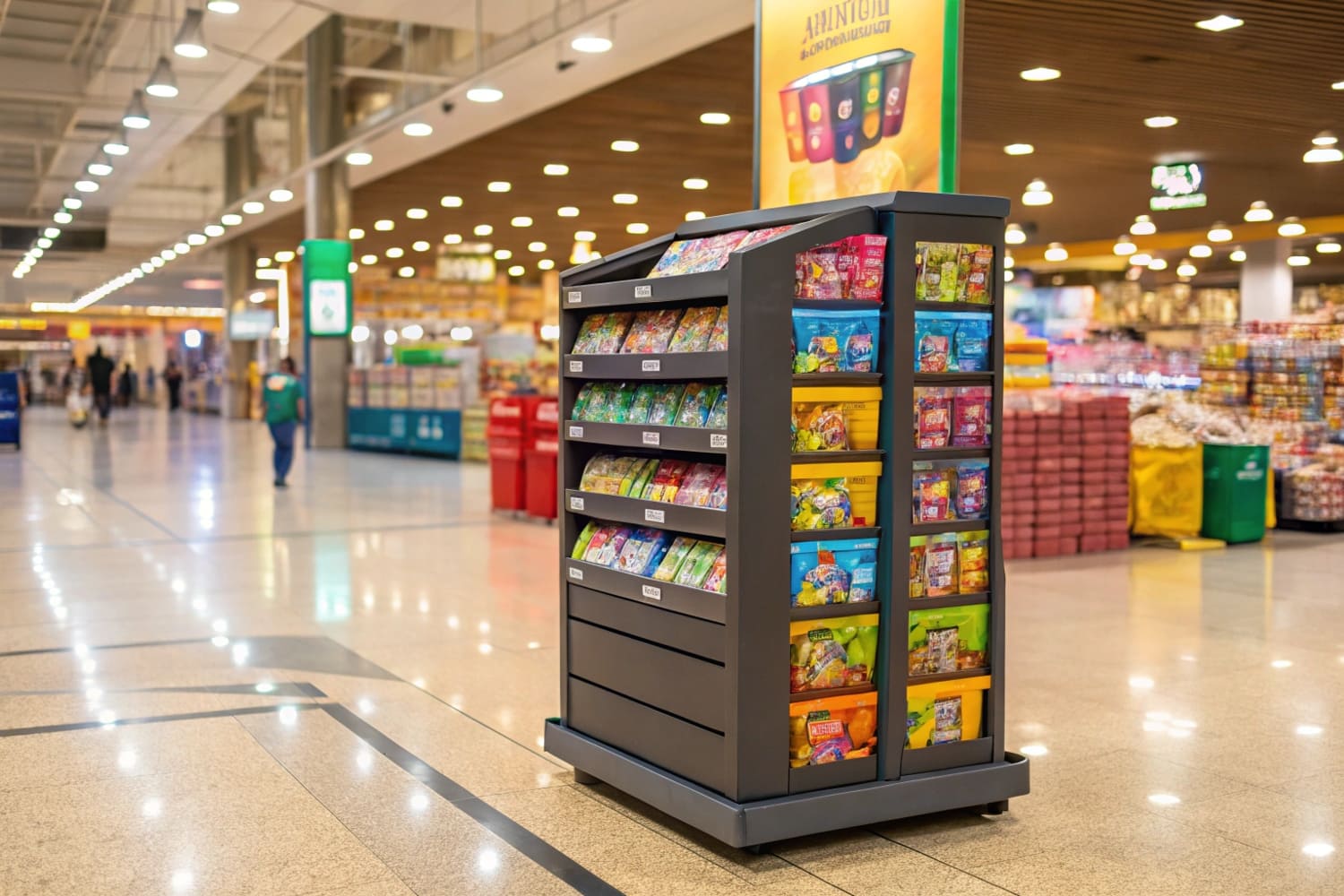You sometimes feel lost in front of a shelf that overflows with options, yet one brightly printed box still snatches your eye and wins your wallet.
Common point‑of‑sale displays include cardboard countertop units, floor‑standing dump bins, and end‑cap shelving that place impulse products at checkout and drive instant add‑on sales.

The next sections walk through every core question I meet when guiding clients who need simple, strong, and timely cardboard solutions.
What is an example of a point of sales display?
Many shoppers first meet a new snack or gadget right beside the card reader. That thin slice of time is prime space for clever design that sparks a quick “yes”.
A point‑of‑sales display example is a small cardboard countertop stand that holds single‑serve gum packs near the cash register so customers grab them while paying.
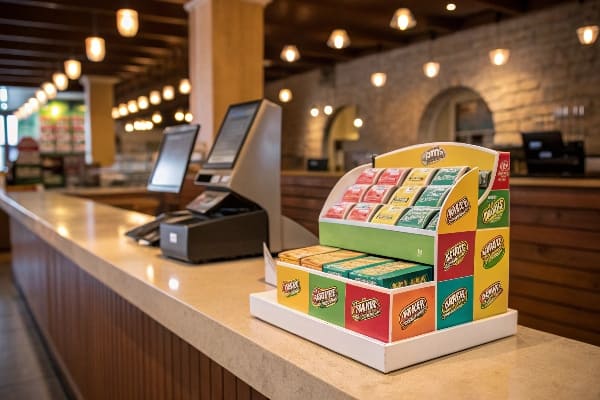
Why the humble countertop stand works
I often rely on this format because it ships flat, pops up in seconds, and costs little. Below I break down the main reasons.
| Factor | How it helps sales | What I watch during production |
|---|---|---|
| Eye level placement1 | Shoppers see the item while waiting | I set the height at 15‑20 cm for sight lines |
| Limited SKU slots | Choice feels simple, no overload | I design 6‑8 pockets so stockers refill fast |
| Graphic punch2 | Bright colors shout the offer | I insist on high‑contrast CMYK and spot UV |
| Low unit weight | Store staff lift it easily | Double‑wall‑B flute holds up to 1 kg per tier |
| Quick changeover3 | Easy to swap seasonal art | I keep templates so re‑orders need minor edits |
When David from Barnett Outdoors rolled out a new broadhead line, I used this stand design. His team loaded sample heads into clear blister packs, slid them into the die‑cut slots, and placed the unit next to archery licenses. The small footprint avoided conflict with other brands yet still scored a 27 % uplift in attachment rate during the opening weekend. I glued an internal brace to survive heavy hands, then printed a QR code that pointed to a hunting video. That extra touch earned brand story views long after the buyer left the store. The lesson: a simple stand, built on sturdy board and fresh art, often moves the needle better than a huge fixture.
What is the point of sale display?
Shoppers decide in seconds and I must earn those seconds with clarity, not clutter. The display is my silent salesperson that never clocks out.
A point‑of‑sale display is any branded fixture placed at the checkout area whose goal is to trigger swift, last‑minute purchases without staff assistance.
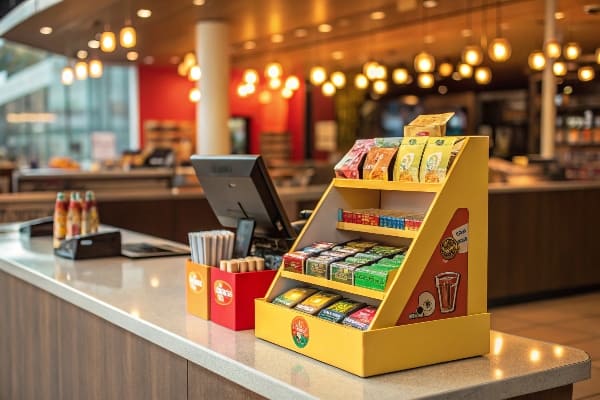
Core jobs a POS display must perform
I audit every concept against three short tasks—catch, convey, convert.
| Job | Key action | Design check |
|---|---|---|
| Catch4 | Stop moving eyes | Contrast, motion lines, or lighting |
| Convey5 | Tell value fast | Five‑word headline and clear price |
| Convert6 | Guide hand to product | Easy reach slot and tidy restock path |
For example, when I developed a floor spinner for energy shots at a gas‑station chain, I used a black base and neon green shelves. The contrast pulled drivers who were scanning for coffee. A bold “99¢ Now” on each tier told the deal. Finally, each slot tilted forward three degrees so bottles rolled within reach but did not fall. That simple physics choice improved pick rate by 18 % and shaved refill time by half. Remember, the display’s job is not to lecture; it makes the purchase friction‑free.
What is an example of a point of sale?
A point of sale is more than furniture. It is the physical spot where money changes hands and decisions lock in.
A cashier counter in a grocery store where the barcode scanner, payment terminal, and receipt printer sit together is a point of sale.

Linking the hardware to the display
While I build cardboard, I still map the hardware flow because space is tight and rules vary.
| Element | Why it matters to display placement | My planning tip |
|---|---|---|
| Scanner | Needs clear sight line | Keep display below sensor height |
| Card reader | Customer zones focus here | Angle graphics toward reader |
| Conveyor belt | Moves items forward | Avoid overhang that blocks belt |
| Bag area | Final grab moment | Place small add‑on trays here |
| Queue divider | Sets visual boundary | Use color to echo brand theme |
I once helped a pharmacy chain add a slim vitamin strip above the belt exit. The IT team warned me about barcode misreads7 if shiny lamination reflected the laser. I switched to a matte water‑based varnish8. The result kept both the tech team and the marketing team happy, and boosted vitamin sales by 12 % in the first quarter. The lesson: understanding the whole point‑of‑sale ecosystem9 lets my cardboard design slip in smoothly.
What is a typical point of sale display?
Retailers default to proven shapes because they fit most counters, aisles, and budgets. I keep templates ready to save my buyers time.
A typical point‑of‑sale display is a narrow, multi‑shelf cardboard tower placed at aisle ends, holding small packaged goods for impulse add‑ons.
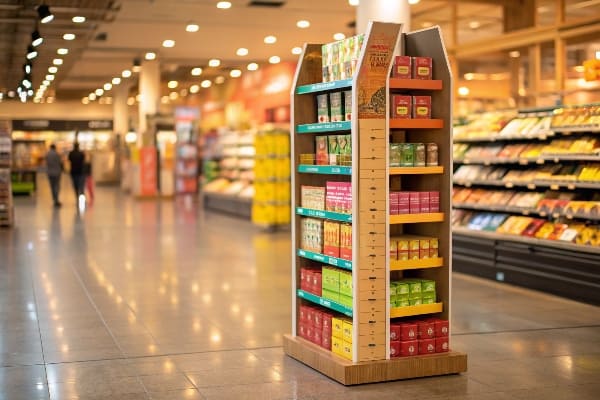
Anatomy of the common tower
Below I open up the design sheet10 that my factory uses for fast quotes.
| Section | Standard size (mm) | Function | Option |
|---|---|---|---|
| Base | 400 × 300 × 80 | Weight spread | Hidden steel plate |
| Body panels | 1400 height | Brand canvas | Emboss logo |
| Shelves | 3–4 tiers ; 80 pitch | SKU slots | Hook or tray |
| Header | 300 × 200 | Price tag | LED strip |
| Knock‑down joints | Tongue & groove | Quick setup | Velcro loop |
A good tower balances capacity with footprint. Too tall and it blocks sight lines; too shallow and it tips. I tested load using 20 kg water jugs11 to mimic heavy crossbow bolts that David sells. The corrugated EB flute passed without bowing. After transit trials with random drop tests, edge crush stayed within 10 % tolerance. I then produced 1,000 units in 12 days thanks to my three automated die‑cut lines12. Such speed helped David catch his fall hunting season launch.
What is the difference between a POS and a pop?
Many marketers mix the two terms and drown in jargon. I keep the difference short.
POS (point of sale) focuses on the checkout space, while POP (point of purchase) covers any in‑store area where buying decisions happen, including aisles and end‑caps.
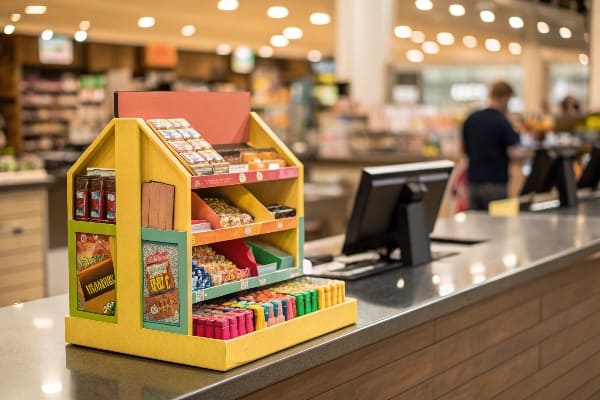
Comparing scope, timing, and design rules
I drop the confusion using a clear table.
| Aspect | POS13 | POP14 |
|---|---|---|
| Location | Checkout counter | Anywhere in store |
| Time in funnel | Final seconds | Exploration phase |
| Primary goal | Impulse add‑on | Brand education or trial |
| Size limits | Small, quick setup | Flexible, can be large |
| Common format | Counter stand, small rack | Pallet display, floor island |
For instance, a weekend pallet display in a warehouse club stacks dozens of crossbow kits with lifestyle graphics. That is POP. It grabs attention from ten steps away and educates with bullet lists and QR links. In contrast, the tiny L‑shaped tray at the register holding wax lube is POS. It slides into an unused corner and relies on speed. When I brief my design team, I always tag each job “POS” or “POP” in bold on the spec sheet so the final dieline meets the right merchandising rules15.
What is a point of purchase example?
Point of purchase may occur far from the till, and timing can span minutes, even hours, as shoppers browse.
A point‑of‑purchase example is a full‑pallet cardboard island in a big‑box store’s center aisle displaying holiday‑themed snack bundles that entice bulk purchasing.

Building an island that sells and survives
My pallet displays face forklift hits, shopper traffic, and strict retailer rules.
| Task | Key detail | My control point |
|---|---|---|
| Compliance | Meets retailer height cap (48 in) | Pre‑validate CAD with retailer portal |
| Graphics | 360‑degree storytelling16 | Wrap‑around print without seams |
| Strength | Holds 300 kg | Use triple‑wall corners17 |
| Replenish | Swap half‑pallet inner | Perforated tear‑away doors |
| Disposal | Easy to break down | Single material for recycling |
When I built a pallet island for a national pet chain, I had to consider kids climbing on it. I added hidden cross braces and printed paw‑shaped floor prints that formed a safe queue path. The display kept its shape for six weeks, twice the planned cycle, which saved the chain two resets and paid for the braces. David watched that rollout and asked me to adapt the idea for his hunting gift bundles. We shortened the wall height and changed the art to forest camouflage. The lesson stands: a sturdy POP island becomes silent, durable real estate that shouts brand values long after the initial excitement fades.
Conclusion
Effective cardboard displays catch eyes, talk fast, and hold firm; choose the right type for each touchpoint, and your product wins moments that matter.
Understanding eye level placement can enhance your retail strategy, ensuring products are seen and sold effectively. ↩
Exploring graphic punch can reveal how vibrant visuals can attract customers and boost sales significantly. ↩
Learning about quick changeover can help streamline your merchandising process, making it more efficient and responsive to trends. ↩
Explore this link to discover innovative techniques that can enhance your POS display’s ability to attract customers effectively. ↩
Learn how to communicate value swiftly in your displays, ensuring customers understand the offer at a glance. ↩
Find out proven methods to turn customer interest into actual sales, optimizing your display’s effectiveness. ↩
Understanding barcode misreads can help improve your display design and sales efficiency. ↩
Explore how matte water-based varnish can enhance product visibility and reduce glare in displays. ↩
Learn about the point-of-sale ecosystem to optimize your display strategies and boost sales. ↩
Understanding design sheets can enhance your knowledge of manufacturing processes and improve your own designs. ↩
Learning about load testing methods can help ensure product safety and reliability in your designs. ↩
Exploring automated die-cut lines can provide insights into efficiency and innovation in production processes. ↩
Explore this link to understand effective POS strategies that can enhance customer engagement and boost sales. ↩
Discover insights on POP displays that can help you create impactful marketing strategies and improve brand visibility. ↩
Learn about crucial merchandising rules that can optimize your retail space and increase product appeal. ↩
Explore this link to understand how 360-degree storytelling can enhance your marketing strategy and engage customers effectively. ↩
Learn about the advantages of triple-wall corners for strength and durability in packaging solutions, ensuring your products are well-protected. ↩

